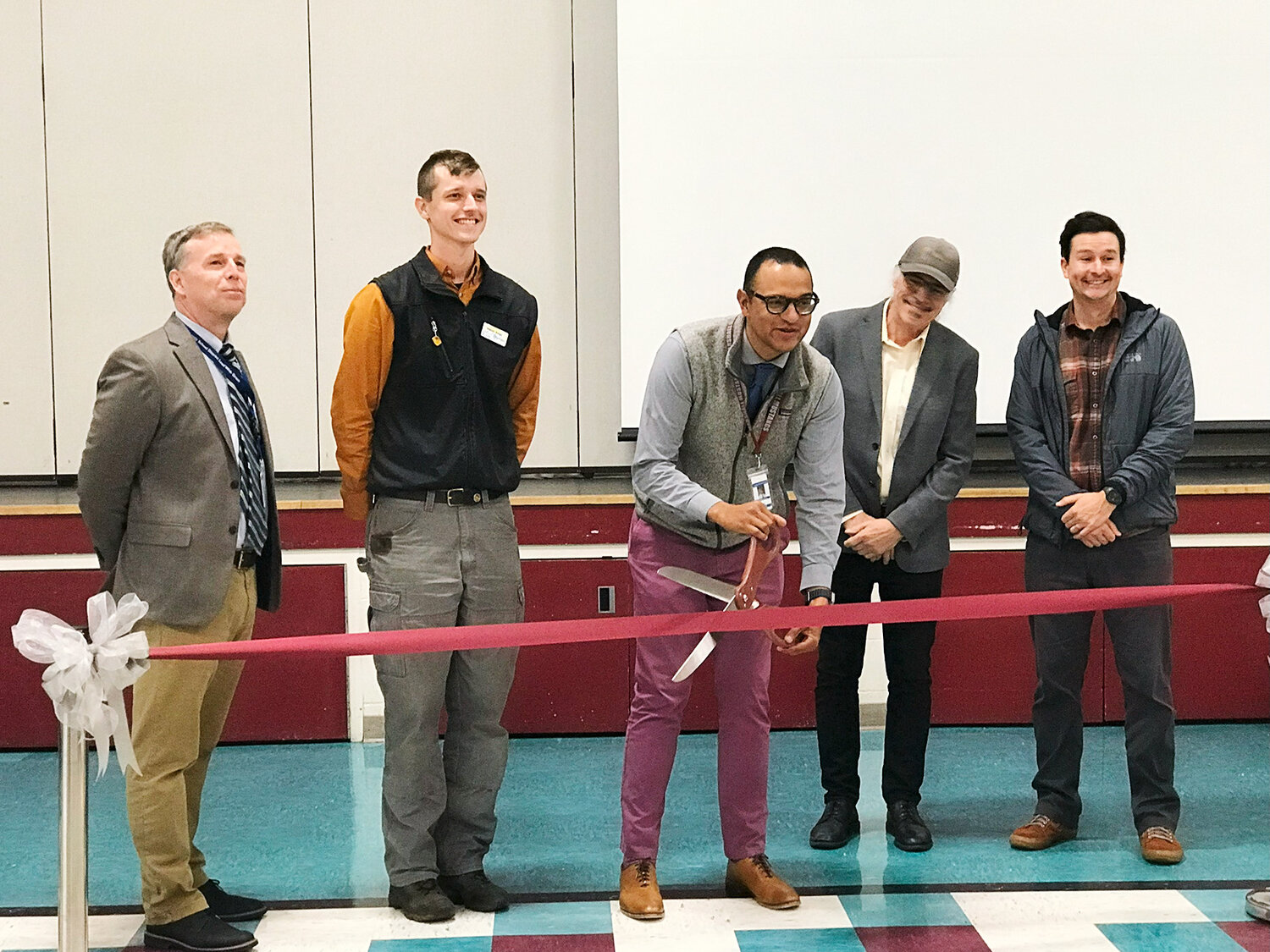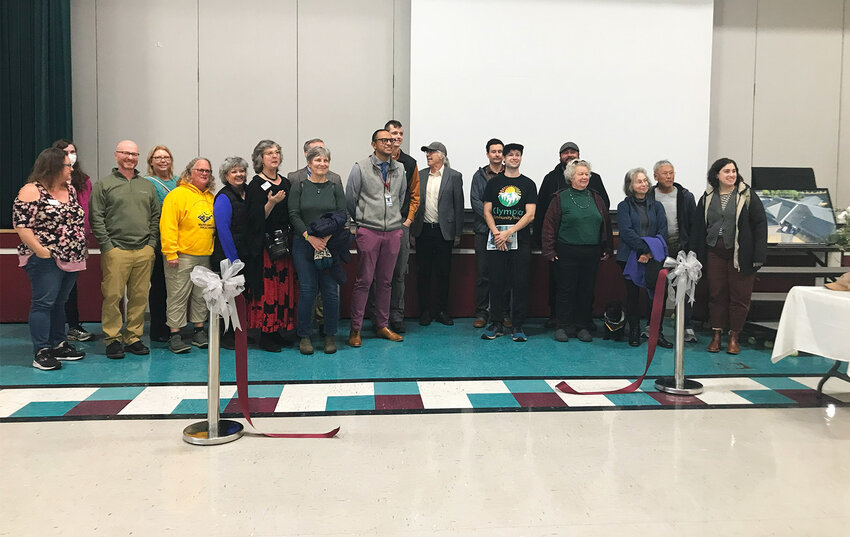Community members joined legislators, teachers, school board members, nonprofit developers, solar sector professionals, donors and lenders on Wednesday, November 1 for a ribbon-cutting ceremony to inaugurate Thurgood Marshall Middle School’s Community Solar Project, a newly completed 306-panel solar array on the school’s roof.
The project is a joint development between the Olympia School District and local clean energy nonprofit Olympia Community Solar, installed by regional solar company Puget Sound Solar and financed by Washington State University’s Community Solar Expansion program and a short-term bridge loan from community lender Craft3.
Affordable model of community solar energy
The solar project represents a new model of affordable, ultra-local, collectively-owned clean energy that removes some of the barriers facing would-be solar clients by improving solar access for community members who don’t own their homes, whose properties lack a suitable roof or sufficient daily sun exposure, or who have been deterred by the upfront cost of transitioning to solar technology.
The community solar model imports the perks of a conventional centralized power grid for residential customers without the harmful emissions of fossil fuels or the unsightly and habitat-damaging sprawl of larger-scale solar farms.
Wednesday’s celebration, held in the school’s cafeteria, kicked off with an introduction from Olympia Community Solar’s president, Mason Rolph.
The start
Rolph first approached the school district in 2016 with his college thesis, a community solar proposal that wasn’t ultimately adopted, however it started a successfully implemented project with the Hands On Children’s Museum in downtown Olympia.
Now, seven years after his initial proposal, Rolph was able to complete a school-based solar array.
Rolph explained the model at the ceremony:
“The Thurgood Marshall community solar array consists of 306 solar panels that make up 150 kilowatts of generating capacity. 150 kilowatts. In English that’s about 15 homes worth of energy, or about a third of the school’s electricity,” said Rolph. “And a really cool thing about this project is it’s community-owned.”
“Our nonprofit leased the roof out from the school and we organized community members and grants to fund the system,” Rolph added.
Into the future, who benefits
For its first 15 years, Rolph says, his organization will manage and operate the installation. The school will enjoy some reduction in energy costs, and some energy benefits will be distributed to individual participants who invested in the project by donating or purchasing solar panels or by subscribing to power generated by the completed grid.
The majority of the benefits – 90% – will be allocated to Homes First, a local nonprofit that builds and maintains housing for low- and very-low-income South Sound residents.
After 15 years, the project will be donated to the school and is ultimately expected to yield around $920,000 in energy savings for the school district throughout the array’s 40-year lifetime.
“I think it’s very fitting that this project is at Supreme Court Justice Thurgood Marshall Middle School, and is benefiting those that have been underserved in our community,” said Patrick Murphy, Olympia School District superintendent. “So I just want to really thank you for that. I think that’s huge. And what a great dovetail to our own student outcomes.”
Murphy said he encourages civic engagement, collaboration, critical thinking, and environmental stewardship.
A hands-on experience for the kids
Anthony Brock, Thurgood Marshall Middle School’s principal, praised the project’s dividends for both the community and his students.
7th and 8th graders at Marshall have been engaged in an energy-efficient tiny house project for a couple of years, said Brock, “But it’s always been from like a textbook or looking online. And so, I get excited because with the vendor right here at the school . . . we can see what energy is being generated daily, monthly, yearly. really see that impact and then apply that when they get into their classrooms.”
Stu Frothingham of Puget Sound Solar – “the vendor” – echoed Brock’s testament to student enthusiasm for the project. “We had a chance to come and talk to several groups of students here and just getting to kind of say, ‘Oh, in the next project, we’ll be right here on the rooftop!’ It felt like the room was suddenly filled with bees . . . and plus I think middle school students are my favorite educational audience that we ever talk to. They’re the best, best audience.”
“Yes, they are!” called Principal Brock from the crowd.
Roadblocks and costs weighed
Jeremy Smithson, owner and CEO of Puget Sound Solar, then addressed some roadblocks facing the renewables sector:
“Our utilities are kind of like deer in the headlights right now, realizing how much power they have to produce . . . designing a system that is cost-effective and code-compliant amid constantly-changing product offerings has its own set of dilemmas that we call the ‘solar coaster,’ because nothing is the same from year to year. I’m proud of our team’s ability to navigate these waters and this project is a great example of that.”
The solar array at Thurgood Marshall is the first project commissioned by Washington State University’s new low-income community solar program, which was established in response to legislative approval of Second Substitute House Bill 1814 (2SHB 1814) in 2022. This state incentive program aims to “ equitable access to the benefits of renewable energy through community solar projects.”
Old infrastructure and new savings
Technology for harnessing the sun’s energy photovoltaically has historically been prohibitively expensive, and while it’s broadly acknowledged that fossil fuels – coal, oil, and natural gas – emit planet-warming gases that contribute to climate change and may be damaging to human health, implementing solar alternatives is still regarded as a luxury reserved for affluent do-gooders.
But cost is one of the “false perceptions” about solar, counters Rolph in discussion with JOLT staff.
“Media tends to promote solar as an environmental solution, but almost every customer who invests in solar, invests for the energy savings, to save money,” Rolph said. “It’s not just a way to ‘green your business’ – it’s very much a financial thing. Like it’s pretty much getting people out of the yoke of utility bills.”
Sustainability advocates and free market purists alike may protest the persistence of a centralized power grid monopolized, per government contract, by private sector regional service utilities like Puget Sound Energy. Still, the current system was at one time the cheapest way to reliably distribute power and maintain service infrastructure. But as anyone with a recent utility bill can attest, “the environment” is no longer the best or only argument for exploring increasingly affordable renewable energy technologies.
Outdated grid infrastructure has become more of a hazard than convenience in recent years. It is consistently implicated in the annual megafires that have unfortunately become the “new normal” for those living in the West.
The community solar model, claim its proponents, boasts a bottom-up rather than a top-down energy model; it empowers citizens to invest in collectively and benefit from a utility they control, rather than remaining in thrall to utility companies that are in turn accountable to stakeholders, not to their customers.
With Washington’s commitment to clean energy formalized by 2019’s Clean Energy Transformation Act, Olympia Community Solar and similar groups that aim to steward this transition to clean energy equitably will become increasingly instrumental. Says Rolph: “We know the timeline of when it’s going to happen, and there’s money there to support it. So, the real challenge now is how it happens and who it benefits. That could be the big utility corporations, or it could be the people who deserve to benefit from the power. Our goal is to make sure that people benefit.”





